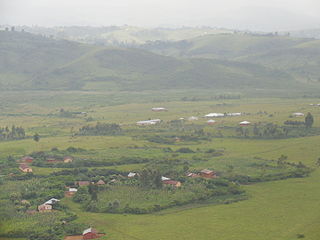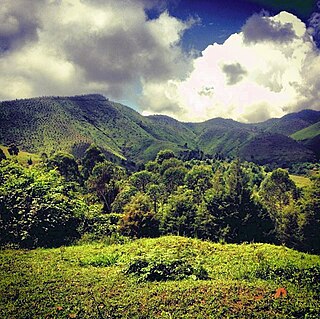
The Ituri conflict is an ongoing low intensity asymmetrical conflict between the agriculturalist Lendu and pastoralist Hema ethnic groups in the Ituri region of the north-eastern Democratic Republic of the Congo (DRC). While the two groups had fought since as early as 1972, the name "Ituri conflict" refers to the period of intense violence between 1999 and 2003. Armed conflict continues to the present day.

Minembwe is a cluster of several villages located in the highlands of Lulenge, within the Fizi Territory of South Kivu Province in the Democratic Republic of the Congo (DRC). It is situated at an altitude of about 2,500 meters above sea level, in a hilly and mountainous region covered with forests, which provides fertile land for agriculture. It lies approximately 150 kilometers southward of Bukavu. The region is interspersed with myriad streams and rivers that flow towards Lake Tanganyika, the second-deepest lake in the world.
Mulenge is a village encircled by hills in the Kigoma groupement (grouping), within Bafuliiru Chiefdom, located in the Uvira Territory, South Kivu, in the eastern Democratic Republic of the Congo. It is situated on the high plateaus of the Itombwe massif, overlooking the locality of Uvira. The area has conventionally been inhabited by various ethnic groups, including the remnants of the autochthonous population of African Pygmies, as well as Bantu ethnic groups such as the Mbuti, Fuliiru, and Nyindu. The region boasts high agricultural productivity, with two harvests typically achievable each year.

Bunyakiri is a town located in the high plateau of Kalehe Territory in the South Kivu Province in the eastern region of the Democratic Republic of the Congo (DRC). Bunyakiri is nearby the Bulehe and Mulamba villages. It is mainly inhabited by Tembo, Havu, Twa and Hunde ethnic groups.

Baraka, also known as Bala'a, is the main city and metropolitan center of the Fizi Territory located in the South Kivu Province in the eastern region of the Democratic Republic of the Congo (DRC). Baraka is bordered by the Lweba River to the north, the Mutambala River to the south, Lake Tanganyika to the east, and the Lu'e River, Efuma Mountain, and Makundu Mountain to the west.

The National Coalition of the People for the Sovereignty of Congo, and also known as the Alliance of Article 64, is an armed rebel coalition in the east of the Democratic Republic of the Congo. The group is a coalition of around 12 different Mai-Mai groups in and around South Kivu province. It was formed on 30 June 2017, symbolically Congolese Independence Day.
The Kipupu massacre occurred on 16 July 2020 in the South Kivu village of Kipupu in the Mwenga Territory in the eastern Democratic Republic of the Congo. Gunmen belonging to the Ngumino and Twiganeho militias of the Banyamulenge community attacked the village and reportedly killed 220 people according to provincial lawmakers, while independent analysts state only 18 people were killed.
The 2017 CNPSC offensive was a military offensive launched by rebels of the National Coalition of the People for the Sovereignty of Congo (CNPSC) on 30 June 2017 against security forces of the Democratic Republic of the Congo and MONUSCO. The goal of the offensive was to capture major settlements, mainly in South Kivu province in order to raise support for a popular uprising against then-president Joseph Kabila, who the coalition had deemed as an illegitimate president.
Attacks were carried out by various armed groups in the Democratic Republic of the Congo in 2021 and 2022. The attacks have killed 629 and injured 321. At least 82 perpetrators were also killed and one injured in these attacks.
Lemera is one of the groupements (groupings) within the Bafuliiru Chiefdom, located in the Uvira Territory of the South Kivu Province in the eastern part of the Democratic Republic of the Congo. It is situated in the northwestern part of the Uvira Territory, approximately 60 kilometers north of Bukavu and 90 kilometers southwest of the border with Rwanda and Burundi. Lemera is in close proximity to several villages, including Kasheke, Nyambasha, Luzira, Lukayo, Kajuju, Lushasha, and Ihusi.

Lulenge constitutes one of the four sectors within the Fizi Territory of South Kivu Province, situated in the eastern region of the Democratic Republic of the Congo. Geographically positioned adjacent to the Kiloba and Makena villages at an elevation of 943 meters, the sector's administrative center is Kilembwe. Lulenge is delineated to the north by the Itombwe sector and Mwenga Territory, to the east by Lake Tanganyika and the Mutambala sector, to the south by the N'gangya sector, and to the west by Shabunda Territory.
Bwegera is a village in the Bafuliiru Chiefdom in the Uvira Territory of South Kivu Province, Democratic Republic of the Congo. Bwegera has an elevation of 952 meters and is situated in the vicinity of the Kakamba and Nyaruhuhuma villages. The region It's crossed by Lake Tanganyika, providing a vital source of water and transportation for the local inhabitants. Bwegera is rich in building materials such as rubble, sand, and baked bricks, making it an ideal location for construction and development. The region also encompasses a vast rural area where agriculture, animal breeding, and fishing are the primary means of livelihood.

Mutambala is a sector that constitutes one of the four sectors in the Fizi Territory of the South Kivu Province in the eastern part of the Democratic Republic of the Congo. Mutambala is situated near Lake Tanganyika, in the west by the Lulenge sector, in the north by the Tangani'a sector, and in the south by the Ngandja sector. It has a surface area of 777 km 2. The sector consists of five groupings (groupements), including the Basimukindja groupings, the Batombwe groupings, and the Babwari groupings.

Kilungutwe is a small village in the Luindi Chiefdom, located in the valley of the Kilungutwe River in the Mwenga Territory of the South Kivu Province. Situated in the eastern part of the Democratic Republic of the Congo (DRC), Kilungutwe is positioned nearby neighboring villages of Kirukungutu and Chowe. The region is a melting pot for many ethnic groups, boasting a diverse ethnocultural landscape. It is also a point of confluence for numerous ethnic groups, including the Lega, Nyindu, Shi, Fuliiru, Holoholo, Bwari, Vira, Hunde, Nyanga, Bembe, and Amba people.
The Makobola massacre occurred from December 30, 1998, to January 2, 1999, in the small village of Makobola, located approximately 15 kilometers south of Uvira, on the border between Fizi Territory and Uvira Territory in the South Kivu Province of the Democratic Republic of the Congo (DRC). The Rally for Congolese Democracy, a predominantly Tutsi Rwandan-backed armed group led by Ernest Wamba dia Wamba, killed over 800 civilians, largely belonging to the Babembe community.
Kidote, also known as Kidoti, is a small village situated in the middle plateaux of Lemera, within the Bafuliiru Chiefdom of the Uvira Territory in the South Kivu Province in the eastern region of the Democratic Republic of the Congo (DRC). It also serves as a camp for Congolese Internally Displaced People (IDPs) from various regions of Bwegera.

Kitchanga, also known as Kitshanga, is a town and a camp for Congolese Internally Displaced People (IDPs) strategically positioned between Masisi and Rutshuru territories of the North Kivu Province, with a vantage point overlooking Lake Kivu in the eastern region of the Democratic Republic of the Congo (DRC). Administratively, the Masisi part of Kitchanga functions as a larger urban center and the capital of the Bashali Chiefdom, while the other part is situated in the Bwito Chiefdom of the Rutshuru Territory. Geographically, Kitchanga is located approximately 90 km northwest of Goma and 10 kilometers north of Burungu, in close proximity to the villages of Kizimba and Budey. As of 2015, the population of Kitchanga was estimated at 18,927 for the Masisi Territory part and 25,157 for the Rutshuru Territory, excluding the populace within the displaced sites of Kahe and Mungote adjacent to Kitchanga in the Masisi Territory.
On January 4, 2022, militiamen from the Twiganeho-Makanika armed group ambushed a convoy of Congolese soldiers in the village of Kagogo, South Kivu, Democratic Republic of the Congo.

The Bashali Chiefdom is a chiefdom located in the Masisi Territory of North Kivu Province in the eastern region of the Democratic Republic of the Congo (DRC). Topographically, it is bounded to the east by the Virunga National Park, to the north by the Bwito Chiefdom of Rutshuru Territory, to the northwest by Walikale Territory, to the south by the Bahunde Chiefdom, and to the west by the Osso sector. Encompassing a total area of 1,582 square kilometers, the chiefdom is the administrative and sociopolitical structure for the Hunde ethnic group and is administratively subdivided into two groupements: Bashali-Mokoto and Bashali-Kaembe. Kitchanga, the urban center and administrative capital of the Bashali-Mokoto groupement, is the most densely populated locality within the chiefdom.









